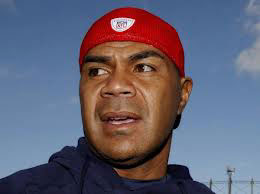

NFL’s Junior Seau had brain disease from blows to head
By Peter Rudegeair and Sharon Begley
(Reuters) – Junior Seau, the 12-time Pro Bowl linebacker who killed himself last year, suffered from the same debilitating brain disease diagnosed in at least two other former NFL defensive players who also committed suicide, a study released on Thursday said.
Seau, 43, died in May after shooting himself in the chest at his beachfront house in his hometown of Oceanside, California. He played mostly for the San Diego Chargers and two other teams in a 20-year career in the National Football League.
A study of Seau’s brain by a team of independent researchers found he suffered from chronic traumatic encephalopathy, or CTE, likely brought on by two decades of blows to the head as a football player, the report said.
Increased awareness and knowledge about brain injuries have unsettled the National Football League, a $9 billion a year industry that rose to popularity largely from the speed and power of its athletes colliding with one another. The league has attempted to institute rule changes protecting player safety while still preserving the spectacle that fans enjoy.
CTE can be diagnosed only after death. Tissue from Seau’s brain was sent to the National Institutes of Health for analysis in July, at the request of Seau’s family, amid growing concern over the long-term effects of football-related head injuries.
“The final diagnosis was findings consistent with chronic traumatic encephalopathy,” Dr. Russell Lonser, the lead researcher on the case, told Reuters. Lonser is chairman of the Department of Neurological Surgery at Ohio State University and led the study of Seau’s brain while he was at NIH.
Patients with CTE may display symptoms “such as impulsivity, forgetfulness, depression, (and) sometimes suicidal ideation,” Lonser said in the report.
Five neuropathologists – two who work for the government and three who were independent and not informed they were examining Seau – came to a consensus on the diagnosis by studying the accumulation of a protein called tau in certain areas of the brain, Lonser said.
The distribution of tau discovered in Seau’s brain “is unique to CTE and distinguishes it from other brain disorders,” the NIH said in a statement about the study.
Several thousand former NFL players have sued the NFL in federal court in Philadelphia, accusing the league of fraudulently concealing from players the risk of brain injury in playing professional football.
The exchange of evidence was on hold pending the NFL’s motion to dismiss the case.
“While the NIH’s findings have provided a measure of comfort, we remain heartbroken that Junior is no longer with us, and are deeply saddened to receive confirmation that he suffered from such a debilitating condition,” Seau’s family said in a statement.
Just weeks before Seau shot himself, former Atlanta Falcons safety Ray Easterling committed suicide, and family members described a long descent into dementia following his retirement from the NFL. An autopsy revealed indications of CTE.
In February 2011, four-time Pro Bowl safety Dave Duerson, who played most of his career with the Chicago Bears, shot himself in the chest. In a suicide note, he donated his brain for study, and it was found to exhibit signs of CTE.
The NFL said the result of the examination of Seau’s brain underscored “the recognized need for additional research to accelerate a fuller understanding of CTE.” NFL clubs have already committed a $30 million research grant to the NIH.
CTE AN ‘INVISIBLE INJURY’
CTE, once known as boxer’s dementia, is caused by repeated impacts to the brain, and has been found in athletes who suffered head injuries as well as members of the armed forces with concussive injuries from blast waves.
Because the mild and moderate brain injuries do not show up on CT scans or other imaging, the condition can be definitively diagnosed only through an autopsy.
The so-called “invisible injury” causes dramatic behavioral and cognitive changes. It can cause depression, aggression, impulsivity and memory loss and has been linked to suicide.
Research led by scientists at Boston University and the Veterans Administration in 2012 showed, through microscopic analysis of the brains of military veterans and young athletes, exactly how repeated head injuries cause CTE and impair mental function.
The trauma strangles blood vessels, diminishing blood flow within the brain, the scientists reported last May. It also breaks components of brain neurons called axons. Axons carry signals between neurons, so when they are damaged, brain signals peter out and thinking is impaired. CTE litters the brain with the chewed-up remnants of neurons and other cells so extensively that the brain seems to be eating itself alive.
CTE also stretches neurons, scientists led by Boston University’s Ann McKee found. That stretching damages them so severely that they resemble neurons in the brain of Alzheimer’s patients and are no longer functional.
The Institute of Medicine, which advises the federal government, has also begun an extensive study on sports-related concussions in youth that will in part examine the long-term consequences from such blows to the head.


Be the first to comment